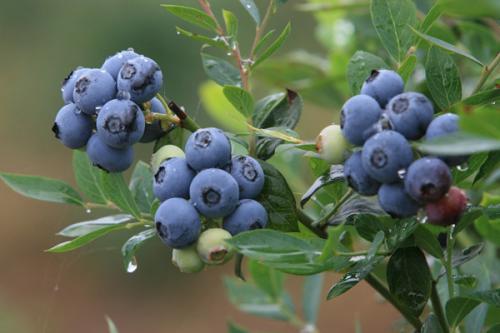How much is the row spacing of blueberries? Introduction to blueberry planting skills and common errors
Blueberries are an important investment in health and happiness, and Nourse Farm can show you how they can produce one of the simplest fruits. Pay proper attention to the pH value of the soil and choose the planting area wisely, which can be harvested for 20-30 years or more!
Studies have shown that eating large amounts of blueberries can improve memory and eyesight. But don't forget to order as early as possible and make sure the pH is below 5.0 to ensure success. Our 18-inch dormant bare-root plants have now been cultured to provide the highest quality and consistency.
Spacing: 4 trees 39 trees between plants 5 trees 39 cm; 8 trees 39 cm between rows; be careful not to plant too deep.
Irrigation: keep the soil moist throughout the establishment.
PH requirements: for best results, please modify the pH value before planting, but if you follow our instructions, you can successfully build the plant without prior adjustment of pH, regularly measure / maintain the pH value for best success, adjusting the pH value may require the addition of sulfur, which is very important.
Wait 4-6 weeks after planting, then fertilize to avoid root burning, 1 to 1 ounce of ammonium sulfate per year in the circular zone around each plant, followed by 2 ounces of flowering time for each plant, and resowing a month later. Do not apply fertilizer after July and avoid fertilizers containing potassium chloride
Healthy berry plants require the following important elements:
Planting skills of blueberries
Early broadcast! Plant as early as possible in spring. Snow or occasional frost will not harm most new plants (except green tissue culture plants), and spring rainfall will promote growth. Planting autumn in the Northeast and Midwest is not recommended.
Where there is plenty of sunshine and no weeds, there will be at least half a day of sunshine.
Clean beds are often weeded.
Well-drained soil. For poor drainage conditions, please consider raising the bed.
Appropriate soil pH value. Matching soil pH to plant needs may be an important factor in your success. Sample the soil before planting and contact the local cooperative extension office for help.
Crop rotation. Avoid growing strawberries or raspberries in the soil of previous crops, including strawberries, raspberries, potatoes, tomatoes, eggplant or chili peppers. These crops may contain soil pathogens Verticillium dahliae, Phytophthora and nematodes, which may affect your new plants.
irrigation. Maintain appropriate water content throughout the season and, most importantly, during establishment. Drip irrigation must be used when planting on an elevated bed.
Avoid common mistakes
Read the free planting guide 1-3 months before planting.
If the roots are too deep or too shallow, plants will not be able to reproduce.
Wrap the soil firmly around the roots.
Do not plant near wild plants or plants of unknown origin.
Water one to three times a week instead of every day.
After the plants are established, fertilizers are applied to avoid fertilizer burning.
Don't soak the plants in water for more than an hour!

- Prev

What are the characteristics of green pineapple? How to grow green pineapple quickly and thickly? what kind of fertilizer should be used?
Green pineapple, commonly known as pothos or devil's ivy, is a perennial climbing vine with waxy, heart-shaped leaves and marble of white or yellow, usually grown in indoor, waiting rooms and commercial interior decorated gondolas. It's an epiphyte.
- Next

When is the best time to plant orange trees? Introduction to the requirements of watering and fertilization for orange tree planting
Oranges We have all eaten this kind of fruit and see dark green leaves decorated with bright orange fruits, which may tempt you to plant your own citrus trees. Do you know whether it is difficult to grow this kind of fruit? How do you plant it? Provide shade and edible
Related
- The first cup of black tea in spring, the flavor and history of tea gardens in Kenya, Africa
- The computer can not only choose potatoes, but also grow tea rice. AI will grow winter oolong tea champion.
- It is not only the inflated tea bitten by insects, but also engraved with the four seasons tea in Beipu.
- The Oriental Beauty Tea Festival in Zhuxian County takes the stage at the weekend to experience the plus-size feast of oil tea.
- & quot; Oriental Beauty Tea & Exploration of Emei in Hsinchu, the hometown of quot;
- The new variety of strawberry "Tainong 1" dessert is the first choice with mellow aroma. Crimson gorgeous
- History of Tea in Taiwan: from Wild Inner Mountain to Export Tea Garden
- Two types of Taiwan Oriental Beauty Black Tea won the British three-Star Award for Childhood Tea Xiang Zhang Jiaqi changed from pilot to champion tea maker.
- Banana species and varieties: the planting history of Taiwan Xianren banana and dwarf banana is long, is banana disease resistant?
- Coffee planting Technology: Qianjie Coffee from Seedling to harvesting

